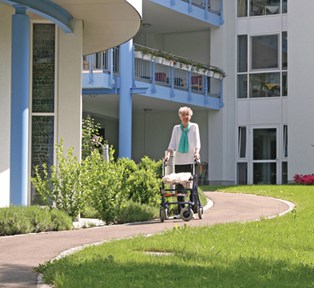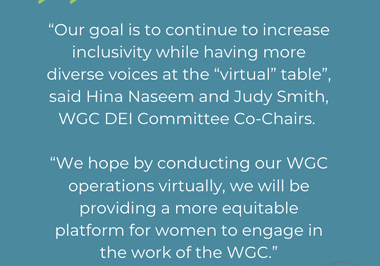A CONSUMER’S GUIDE TO LONG TERM CARE
A STEP-BY-STEP GUIDE
STORY BY Harriet Meyers
Selecting a long-term care facility for a family member can be overwhelming. You may feel emotional as you search through dozens of options. Costs a re often exorbitant. And there’s a confusing array of services to choose from. How can you be confident you are making the right choice? In Howard County, the long-term care ombudsman program in the Office on Aging can help find a facility that meets the needs of your family member. Program Manager Ofelia Ross, and ombudsmen Debbie Beares and Chris Hobbs provide a one-stop-shop of information for consumers free of charge.
re often exorbitant. And there’s a confusing array of services to choose from. How can you be confident you are making the right choice? In Howard County, the long-term care ombudsman program in the Office on Aging can help find a facility that meets the needs of your family member. Program Manager Ofelia Ross, and ombudsmen Debbie Beares and Chris Hobbs provide a one-stop-shop of information for consumers free of charge.
“We take the pulse of the facilities in our county,” says Ross. She and her team make regular visits to see that long-term care facilities meet state requirements and provide good service. They advocate for residents and their families and help them resolve their complaints. And they educate the public about the options open to them.
Ross suggested taking the following steps when you are looking for long-term care:
IDENTIFY YOUR NEEDS
Before you know what type of facility to look for, you must determine your family member’s level of need.
Howard County has five nursing homes and more than 70 assisted living facilities, including both small family-style houses and large apartment complexes. Assisted living may be a good option for people who can no longer live independently, but do not require 24-hour nursing care. These facilities provide housing, meals and assistance with daily activities such as bathing, dressing and medication management. Nursing homes, on the other hand, are designed to serve people who require 24-hour nursing care.
The location is also important. Long-term care residents do better when their family members visit regularly and their concerns are addressed in a timelier manner. Ross can refer you to lists of providers both within and outside of Howard County.
DO YOUR HOMEWORK
Call the ombudsman program at 410-313- 6423 and make an appointment. The ombudsmen can provide resource guides, websites, information about financial aid and more. They can also tell you how many complaints have been filed against specific facilities and what is being done to prevent problems from reoccurring.
MAKE A LIST
Based on the person’s needs and the resources you encounter, you’ll develop lists of questions to ask, attributes to observe and documents to request when you visit each facility. Prepare for these visits by creating a checklist. See sample in box.
VISIT, VISIT AND VISIT AGAIN
It’s a good idea to visit more than one facility to allow comparisons of what each offers. Take someone else along. Visits can be overwhelming, and you might not notice everything on your own. “Use all of your senses when you visit to get as complete a picture as possible,” recommends Ross.
notice everything on your own. “Use all of your senses when you visit to get as complete a picture as possible,” recommends Ross.
For the first visit to a provider, make an appointment. You’ll probably receive a tour and a packet of information to take home, and you’ll have the chance to ask questions. Make the next visit unannounced on a weekend or in the evening. You’ll have a better opportunity to interact with residents and their family members, and you’ll see how the facility is staffed after hours.
Next set up a meeting with the resident council and/or the family council. Most nursing homes have these committees made up of residents and/or their families and friends. They can provide an alternative perspective on the facility’s strengths and weaknesses.
MAKE YOUR DECISION
You’ve collected information from the ombudsman, completed your visits to facilities, asked questions and are ready to sign on the dotted line. Wait!
“Look carefully at the contract agreement before you sign it,” says Ross. “Make sure you know exactly what services are included for the designated fee and how much you will be charged for the a la carte items such as laundry, dispensing medicine and doctor visits,” she cautions.
It is also important to know what Medicare and/or Medicaid programs the facility participates in, she says. If you are paying out of pocket, costs can add up quickly.
And remember: If you or your family member is dissatisfied with a facility, moving is an option. Be sure to check the contract to see how much notice is required.
LONG-TERM CARE CHECKLIST
This is just the tip of the iceberg. Once you talk with the ombudsman and do your research, you are likely to have many additional items to add to your checklist.
Physical Facility
❑Is the location close enough to your home and the homes of other family members?
❑ Is the building well maintained and clean?
❑ Are there pleasant areas inside and outside to visit with residents?
❑ Are common areas wheelchair accessible?
❑ Can residents have personal belongings and furniture in their rooms?
❑ Are handrails and grab bars placed in the hallways and bathrooms?
❑ Are there smoke detectors, sprinklers and an evacuation plan?
Personal Care
❑What is the staff to resident ratio?
❑ How does the staff interact with the residents?
❑ Are residents in their rooms or in common areas?
❑ Are they wearing hospital gowns or their own clothes?
❑ Do residents look clean, well groomed and comfortable?
❑ How often are they engaged in activities or watching entertainment?
❑ How does the facility help residents maintain their abilities to dress, toilet and eat?
❑ Are residents in physical restraints?
❑ Do meals look appetizing and do residents have a choice of food at each meal?
❑ Can special dietary needs be met and are snacks available?
Health Care
❑What is the training and certification of the staff?
❑ What is the ratio of certified nursing assistants and registered nurses to residents during all shifts in nursing homes?
❑ What percentage of residents receives influenza vaccinations?
❑ Is transportation available to take residents to doctors’ appointments?
❑ Who is responsible for obtaining medications?
❑ What kind of therapy is available to residents?
❑ Is specialized care available for residents with dementia?
❑ What is the procedure for notifying family if there is a change in the resident’s health?
Rules and Requirements
❑Is the facility Medicare and Medicaid certified?
❑ How many residents is the facility licensed to serve and how many are living there?
❑ What are the visiting hours?
❑ Who decides which residents share rooms, and how are they matched?
❑ Under what circumstances might a resident be moved to another room or unit or be discharged?
❑ Who handles resident or family concerns?
Request a Copy
❑Inspection survey report (completed annually by the state) – ask how the facility has addressed any of the problems identified in the report
❑ Resident contract agreement – including monthly fees, services included, fees for additional services
❑ Disclosure statement (assisted living facilities)
❑ Notice of resident’s rights
❑ Sample care plan
❑ A month’s activities list
Long-Term Care Information Resources:
Howard County Office on Aging
co.ho.md.us click on “departments” and then “office on aging.”
Howard County Ombudsman Program
410-313-6423
Senior Assisted Housing Program
410-313-5980
Consumer Guide to Long Term Care, Maryland Health Care Commission mhcc.maryland.gov/ consumerinfo/longtermcare/ PreparingForLongTermCare.aspx
Nursing Home Compare, U.S. Medicare medicare.gov
Assisted Living in Maryland – What You Need to Know, Maryland Department of Aging aging.maryland.gov/ documents/ALGuide.pdf
A Consumer Guide to Choosing a Nursing Home, The National Consumer Voice for Quality Long Term Care www.theconsumervoice.org
Medical Assistance for Nursing Home Care, The People’s Law Library of Maryland peoples-law.org/node/1004 Maryland Office of Health Care Quality,
Department of Health and Mental Hygiene dhmh.maryland.gov/ohcq
Informed Patient Institute informedpatientinstitute.org
National Rankings for Nursing Homes healthinsight.org/Internal/ NursingHomesPerformance Rankings.html
Howard County Resource Guide for Older Adults, Persons with Disabilities, and Caregivers, Maryland Access Point Available in the Howard County Office on Aging and other county locations
Guide to Retirement Living SourceBook,State of Maryland Edition retirement-living.com




